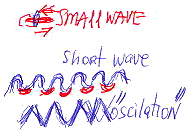| Lower Phase Transition
[Everything
Equation] [Gravity]
[Time]
[Phase Transitions]
[High Phase]
[Quant]
E
(x) |
=1 |
|
(x)
= velocity of swirling |
M |
In lower phase transitions, waves lose energetic matter and
the magnetic loop stands out. During the duality or photon
phase, the photons maintain equilibrium between their magnetic
and energetic properties and both properties are well defined.
This phase is situated between the low phase in which the
wave is in a solid state and a higher phase in which the energetic
structure is obscure.
In a stable formation, the proportion of energy to matter
is as follows:
In higher phases, the energetic loop is enlarged and rotates
at a slower pace (see picture, below left). However, in lower
phases, the energy level drops and the energetic loop is smaller
(picture, below right). Furthermore, the rotation velocity
corresponds with the loss of energy in the energetic loop
as well as the decrease in its size.
 
This phenomenon is represented by the formula to follow:
E
(x*) |
=1 |
|
(x)
= velocity of swirling |
Mag |
This is especially pronounced in neutron stars, which lose
their energetic matter while rotating at unbelievable speeds.
For example, a neutrino — which is a n  independent
magnetic wave with a limited amount of energetic properties
and a high swirl rate — is nearly impossible to track.
It can only be caught within the environment of laboratory
water bath by a wave with greater energetic properties. This
wave behaves like hydrogen, whose properties stand in contrast
to those of the neutrino. Consequently, it is able to attract
and capture the elusive neutrino. independent
magnetic wave with a limited amount of energetic properties
and a high swirl rate — is nearly impossible to track.
It can only be caught within the environment of laboratory
water bath by a wave with greater energetic properties. This
wave behaves like hydrogen, whose properties stand in contrast
to those of the neutrino. Consequently, it is able to attract
and capture the elusive neutrino.
Every formation loses energy. This causes magnetic properties
to increase, while the energetic loop becomes proportionally
smaller and the wave transforms into particle formations.
Swirling waves disperse their energy in wave mode primarily
from their energetic loops, and as they lose energy their
speed accelerates.
This explains why an ultraviolet wave is more energetic than
an ultra-red wave, as in the former its magnetic loop is dominant
(picture, below), and the magnetic loop contains significantly
more energy and rotates at greater speeds.

Next
[Everything
Equation] [ Gravity]
[ Time]
[Phase Transitions]
[High Phase]
[Quant]
Dr. Chaim Tejman, Copyright© 2001. All rights reserved.
[Index]
[Summary]
[Introduction] [Book]
[Wave Formation] [Photons]
[Gravitation] [Time]
[Atoms] [Life]
[Cancer] [Fundamental
Force] [Gender/Why Sex?] [Sexual
Reproduction] [Schrodinger
& Heisenberg] [Creation]
[Supernova] [Dark
Matter & Astronomy] [Speed of
Light] [Cloud Formations]
[Natural Disasters] [Global
Warming] [Thermodynamics] [Backward
Time] [Quantum Mechanics] [Compton
Effect] [Predictions] [Academic
Correspondences] [Contact] [Links]
[Mysteries]
|